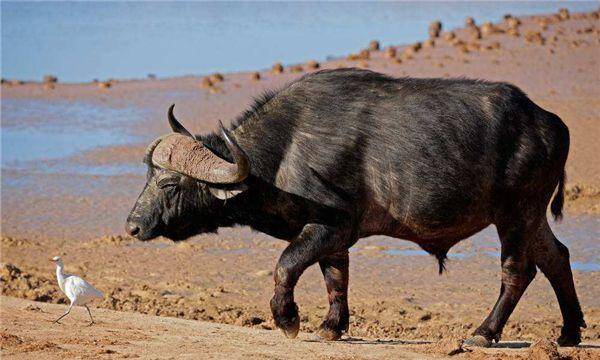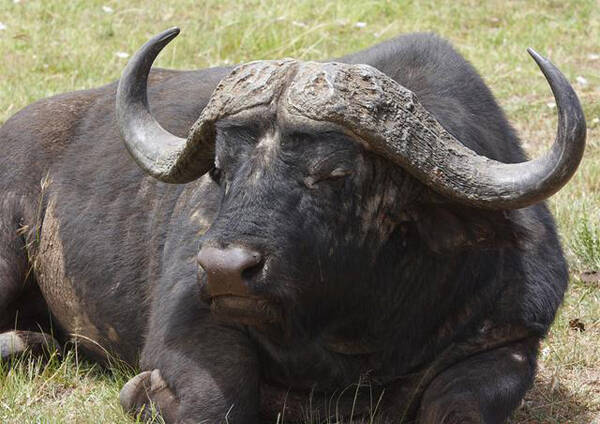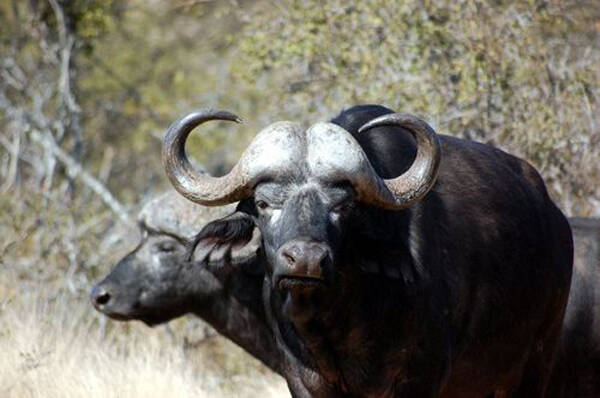Syncerus caffer
IUCN
LCBasic Information
Scientific classification
- name:Syncerus caffer
- Scientific Name:Syncerus caffer, African Buffalo, Buffle d'Afrique,African buffalo, African buffalo
- Outline:Ungulata
- Family:Artiodactyla Bovidae C.buffalo
Vital signs
- length:2.1-3.4m
- Weight:300-900kg
- lifetime:20-25years
Feature
It has a broad chest, strong limbs, a large head with long horns, and a fringe of hair at the tip of its tail.
Distribution and Habitat
Origin: Angola, Benin, Botswana, Burkina Faso, Burundi, Cameroon, Central African Republic, Chad, Congo, Democratic Republic of Congo, Côte d'Ivoire, Equatorial Guinea, Ethiopia, Gabon, Ghana, Guinea, Guinea-Bissau, Kenya, Liberia, Malawi, Mali, Mozambique, Namibia, Niger, Nigeria, Rwanda, Senegal, Sierra Leone, Somalia, South Africa, South Sudan, Sudan, United Republic of Tanzania, Togo, Uganda, Zambia, Zimbabwe.
Regional extinction: Eritrea, Gambia.
Reintroduction: Swaziland.
The habitat of the African wild buffalo is wide, including open grasslands, woodland savannas with abundant drinking water, mountain grasslands, forested areas, and lowland rainforests. They inhabit altitudes up to 4,000 meters. In sub-Saharan Africa. This species is found throughout the driest areas of the region.
Appearance
The African buffalo has a head-body length of 2.1-3.4 meters, a height of 1-1.7 meters, and a weight of 300-900 kg. It has a broad chest, strong limbs, a large head and long horns. The male's horns spread outward and downward from the head. In some males, the horns are connected by a large shield covering the head, which is called a "boss". The soft hair on the top of the head is attached to the large, drooping ears. The body is usually covered with sparse hair, usually ranging from brown to black. Long tail with a hair fringe at the tip of the tail. Male individuals are larger than females, and their horns are also larger, longer and thicker. The savannah species can reach twice the size of the forest-dwelling species. Mature males of the southern savannah subspecies can reach a length of 340 cm and a weight of 700-900 kg, while the forest buffalo subspecies are less than 120 cm tall and weigh less than 320 kg. There are 5 subspecies of African buffalo, which vary great
Details
African buffalo (scientific name: Syncerus caffer) is called African Buffalo in English and Buffle d'Afrique in French. There are 5 subspecies.

African buffalo is a herd animal. Only old or injured individuals will be alone. The strongest bull in the herd becomes the leader of the herd, commanding the herd and having the right to eat the best grass and food. African buffalo love water, drinking at least once a day and never straying from a water source. They are nocturnal animals, avoiding the hot sun during the day, often hiding in the shade or soaking in pools of water or mud to keep their bodies cool. African buffalo is one of the most dangerous animals in Africa (the others are Elephants-Are-Endangered.html">elephants, black rhinos, hippos and crocodiles), the most aggressive and ill-tempered species, and one of the most dangerous animals in Africa. Injured, solitary cows or cows with calves are particularly aggressive and are as dangerous as lions and leopards.
The savanna subspecies can form large herds of more than 1,000 animals. Due to their more confined habitat, forest buffalo generally form small groups of up to 12 animals, including adult females and their offspring and one or more males. Males that do not belong to a group are solitary, or form bachelor herds. Living in a herd has its advantages as food from the best pastures can be shared between herd members and it also provides better protection against predators.
Cooperation between females in herds is strong and if a member is attacked by a carnivore such as a lion, the rest of the herd will respond to its roaring cries for help and rush to its defense. A herd of buffalo can easily drive off an entire pride of lions to protect the safety of all the herd members. The size of the group that the forest buffalo live in is not important as they live in a habitat that is not suitable for carnivores such as lions and can easily go into cover if needed.

To escape the heat, African buffaloes spend most of their time lying in the shade. They often appear near drinking water ponds in the early morning and evening, and most of their feeding takes place in the cool of the night. African buffaloes graze on fresh grass, and when grass is scarce, they can only turn to herbs, shrubs and tree plants. The buffalo's eating habits open up areas of long grass to other species with more selective eating habits, and therefore play an important ecological role in the savannas of sub-Saharan Africa.
Mating and birthing in the buffalo are strictly confined to the rainy season. Females usually give birth to their first calf around the age of 5, and give birth every other year, while males begin mating around the age of 7. The estrus period for the buffalo is between March and May, with a gestation period of about 11 months, and calves are born between January and April. The cow will keep a close eye on the calf's safety while keeping other bulls away. This is quite difficult, as a bull in estrus can cause him to attack the calf or other bulls. The bond between the buffalo mother and calf is very close, and the calf can move around on its own soon after birth. In just a few hours, a newborn calf is able to keep up with its herd. For the first few weeks, newborn calves remain hidden in the vegetation, while lactating cows occasionally join the herd. Calves are kept in a safe area in the center of the herd. The calf mortality rate is as high as 80%. Calves are weaned at 10 months old. Bulls are expelled from their mother's herd at around 15 months old and have to join other herds of the same age. They will officially join the buffalo herd at the age of 2. The average lifespan is 20-25 years.

Although the population of African wild buffalo remains considerable, hunting, habitat loss and disease have greatly reduced the population of the herd. In several southern regions of South Africa, African wild buffalo have never recovered to the population numbers they had before the devastating rinderpest epidemic that occurred in the 1890s. During the height of the rinderpest epidemic in the 1890s, the Buffalo State in Africa suffered the most devastation, and combined with pleuropneumonia, mortality rates of up to 95% in livestock and wild ungulates (1998). As rinderpest has spread from cattle to other wildlife, other diseases such as anthrax continued to cause localized declines and extinctions of cattle throughout the 20th century.
The survival of most wild cattle species in the world is believed to depend on their proper protection. Fortunately, the African wild buffalo lives in numerous national parks and reserves, such as the Serengeti National Park and Kilimanjaro National Park in Tanzania, and is well represented.
Listed in the IUCN Red List of Threatened Species 2018 ver3.1 - Near Threatened (NT).
Protect wild animals and stop eating game.
Maintaining ecological balance is everyone's responsibility!








